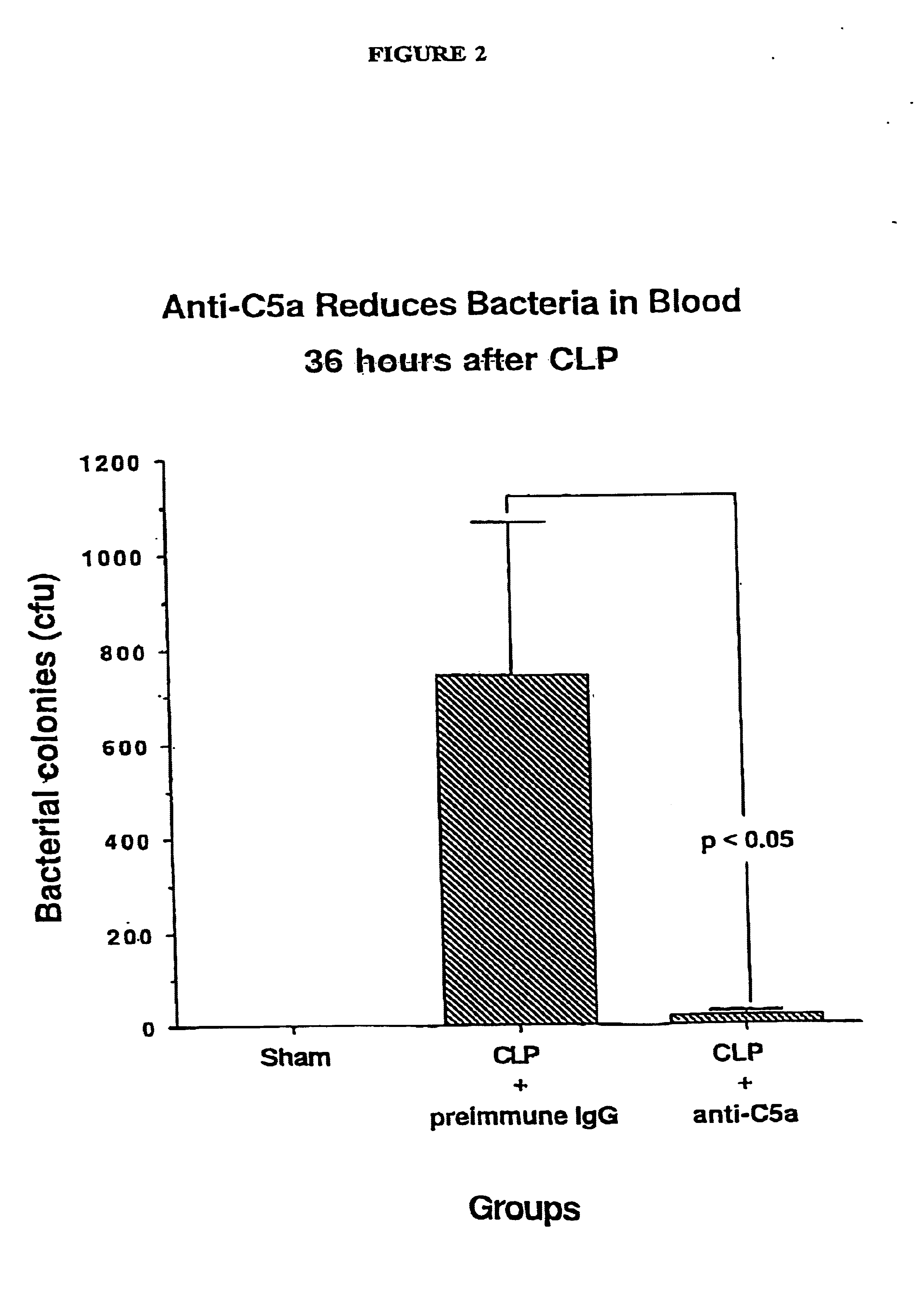Compositions and methods for the treatment of sepsis
a sepsis and composition technology, applied in the field of compositions and methods, can solve the problems of increasing the incidence and mortality of sepsis, increasing the incidence of sepsis, and increasing the mortality of patients, so as to reduce the binding of the complement component c5a peptide, reduce the bacteremia, and increase the h2o2 production of neutrophils
- Summary
- Abstract
- Description
- Claims
- Application Information
AI Technical Summary
Benefits of technology
Problems solved by technology
Method used
Image
Examples
example 1
Induction of Sepsis In Rats by Cecal Ligation Puncture
[0128]This Examples describes the induction of sepsis by Cecal Ligation Puncture (CLP) in Male Long-Evans specific pathogen-free rats (275-300 mg) obtained from Harlan, Inc., Indianapolis, Ind. Anesthesia was induced by intraperitoneal administration of ketamine (20 mg / 100 mg body weight). Through a 2 cm abdominal midline incision the cecum was ligated below the ileocecal valve without obstructing the ileum or colon. The cecum was then subjected to a single “through and through” perforation with a 21-gauge needle. After repositioning the bowel, the abdominal incision was closed in lagers with plain gut surgical suture 4-0 (Ethicon, Inc., Somerville, N.J.) and metallic clips. Sham animals underwent the same procedure except for ligation and puncture of the cecum.
example 2
Preparation and Characterization of Anti-rat C5a Antibodies
[0129]This Example describes the preparation and characterization of anti-rat C5a antibodies. Rat C5a peptide with the sequence KHRVPKKCCYDGARENKYET (SEQ ID NO:2) was obtained from Research Genetics (Huntsville Ala.) and coupled to keyhole limpet hemocyanin (KLH). This 20-mer rat C-terminal truncated C5a peptide corresponds to amino acid residues 17-36 of the full length rat C5a peptide [Rothermel, E. et al., Biochimica. et Biophysica. Acta. 1351:9-12, (1997)], which is listed as SEQ ID NO: 1. The coupled peptide was used as an antigen to immunize rabbits. After several injections, the antibody was affinity purified using the synthetic 20-mer peptide coupled to beads. Immunoprecipitation with activated rat serum using beads coupled with this antibody yielded a single band with a 14 kDa position in Western blot analysis, characteristic of rat C5a peptide [See, Ward, P. A. and Becker, E. L., J. Exp. Med. 127:693-709 (1968)].
[0...
example 3
Anti-Rat C5a Antibodies Prevent Sepsis
[0131]This Example describes the treatment of sepsis. CLP-induced sepsis was generated in three different groups of rats according to the procedure of Example 1 above. The first group (n=21) was treated intravenously with 400 μg of preimmune IgG (in a volume of 300 μg) immediately after the CLP procedure. The second group (n=10) was treated intravenously with 400 μg of anti-C5a IgG prepared according to Example 2 above (in a volume of 300 μg) immediately after the CLP procedure. The third group (n=12) was depleted of C3 by four intraperitoneal injections of purified cobra venom factor (25 units per injection at 12 hour intervals) during the 48 hour period prior to induction of CLP. This protocol has been shown to reduce serum C3 levels to less than 3% of normal and to suppress whole complement hemolytic activity (CH50) to undetectable levels [Hill, J. H. and Ward, P.A., J. Exp. Med. 133:885-900, (1971)].
[0132]Survival rates for the three groups ...
PUM
| Property | Measurement | Unit |
|---|---|---|
| Composition | aaaaa | aaaaa |
| Length | aaaaa | aaaaa |
Abstract
Description
Claims
Application Information
 Login to View More
Login to View More - R&D
- Intellectual Property
- Life Sciences
- Materials
- Tech Scout
- Unparalleled Data Quality
- Higher Quality Content
- 60% Fewer Hallucinations
Browse by: Latest US Patents, China's latest patents, Technical Efficacy Thesaurus, Application Domain, Technology Topic, Popular Technical Reports.
© 2025 PatSnap. All rights reserved.Legal|Privacy policy|Modern Slavery Act Transparency Statement|Sitemap|About US| Contact US: help@patsnap.com



